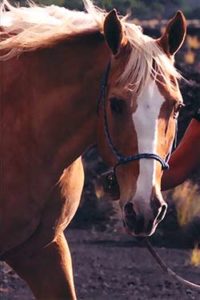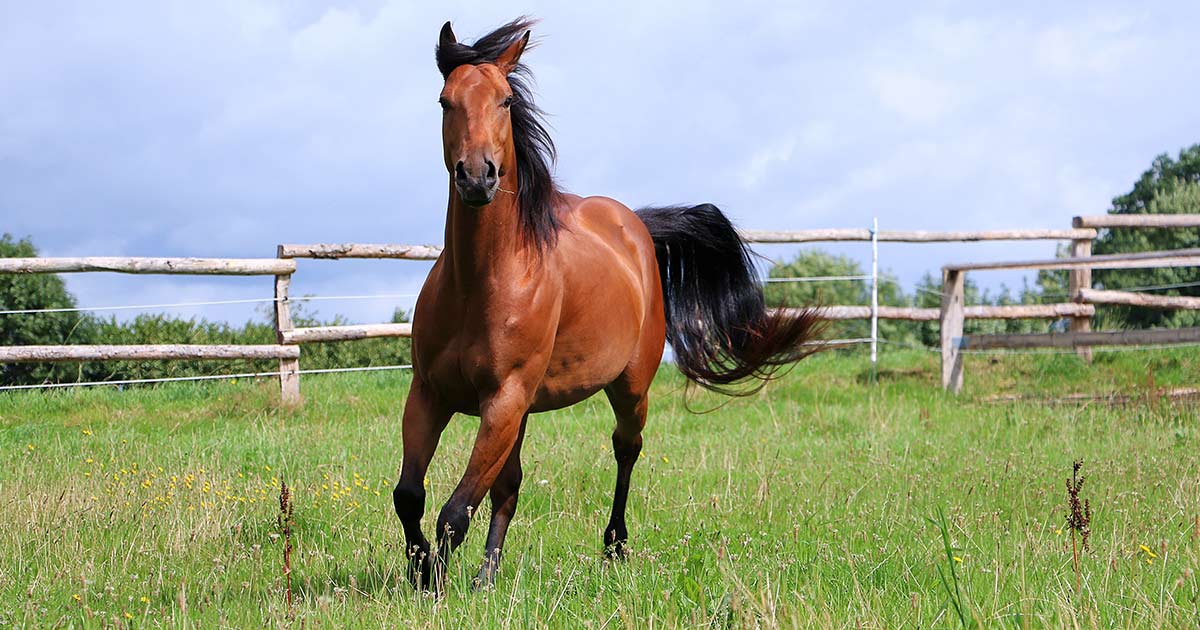One night, while Pat and I enjoyed a nice dinner at the Sweet Basil Bistro in our home town of Big Bear, CA, I casually mentioned that we could move after Smoke “jumped the rainbow.” Pat looked into my eyes and said quite seriously, “Well, I’ll miss you. I’m not waiting till then.” I cried myself to sleep that night…I would miss him too! But, in the morning, he said we would figure it all out. Whew…
Shipping a large animal from the mainland to Hawaii sounds like a very scary thing.
It sure did to me!
Knowledge brings understanding, which brings peace
That is when I decided I better do my research; that it was up to me to understand the process, then make the best decision for Smoke’s future travels.

Smoke as he exited the plane at Kailua-Kona Int’l Airport
Yes, there are only two ways to get a horse, or other livestock to Hawaii. Sail them or fly them. That’s it! As I did my research I came to understand that although sailing a large animal was about half the price of flying one, I also came to understand that the condition of the animal upon arrival was most important to me. Horses don’t do well on the high seas! Many become sick, even die during the trip. And, if they do arrive safely, their original disposition can be permanently altered. There was NO way I was going to do that to Smoke.
Our dear friends, Karen and John Fitzgerald sailed their buggy horse, Ruby, from the mainland. She did just fine. But, that isn’t always the case. And, it can take two weeks to get your horse from the mainland to Hawaii using this method. As far as I was concerned, this was a no-go!

Palmer
flying is safer and faster!
In the process of learning how to fly my horse to Hawaii, I discovered Pacific Airlift, located in Clovis, CA. They had a great website which answered many of my questions, but talking with them over numerous phone calls helped to put my heart at ease. www.pacificairlift.com. Here’s how it works:
In the process of learning how to fly my horse to Hawaii, I discovered Pacific Airlift, located in Clovis, CA. They had a great website which answered many of my questions, but talking with them over numerous phone calls helped to put my heart at ease. www.pacificairlift.com. Here’s how it works:
- You download their State of Hawaii required documents.
- You contact your vet to let him/her know what is coming up. You will need about two weeks minimum get through the entire process.
- The vet does a wellness check, takes blood for the mandatory Coggin’s Test, and gives the animal a USDA Animal and Plant Health Inspection Service approved equine encephalomyelitis vaccine.
- If the animal has no distinctive tattoo or previous identification chip, a chip is inserted.
- The vet must receive the negative Coggin’s test results, come back and check the horse, spray the horse for pests, and then sign the release. The completed documents must be provided to Pacific Airlift three days prior to flying.
- The night prior to flying, the horse must be delivered to Los Angeles International Airport Pacific Airlift Cargo. If the horse is out-of-state you will need to make arrangements with a transport company to get the horse delivered, or trailer it yourself. My horse had to arrive about 11:00 pm. It’s a wild experience to deliver your beloved animal to this enormous airport facility, unload him/her, and then watch as they reload your horse into an open three-part compartment trailer and pull away into the bowels of the cargo building. That is when faith kicks in! You say your goodbyes and your prayers with confidence you will be re-united 15 to 17 hours later at the Kailua-Kona International Airport.
- As promised, as you wait on a boiling hot auxiliary landing strip, you suddenly see, in the distance, a small tractor pulling that three-part compartment with your beloved looking around and wondering what has happened! The driver stops, turns off the motor, opens the gate, backs your horse out, hands you the lead rope, and off you go! OMG!!! You breathe a sigh of relief.
important note:
If you don’t pay strict attention to every detail, and be sure that each step is done exactly when it is required, you could send your horse off only to be notified that you blew it and the horse is heading back to LAX! In my opinion, this would be a disaster. Also, Pacific Airlift only flies about twice a month. If you miss your flight you have to wait possibly two weeks to try again. Honestly, you can’t pay close enough attention to the process!!!
people always ask me …
Is the horse given drugs prior to flying?
Did I go with Smoke?
What did he eat along the way?
How was Smoke when you picked him up at the airport?
He looked fabulous! But, the story of actually getting him to the airport was hair-raising. You can read about it in my book My Year in a Yurt – available on Amazon.
Would you do it again?
How much does it cost?
What does it feel like for the horse to fly in an airplane?
Do they fly directly to Kona?
Are they released directly to you or do they have to be quarantined?
P.S.
Your vet must come within 45 days of arrival to do a follow-up check and complete the final State of Hawaii document. I have no idea what would happen if you fail to complete this process…come and take your horse away? I wouldn’t want to find out!
Pacific Airlift flies race horses, show horses, cattle, burros, even rhinos worldwide. I guess if a million dollar equine can do it, so can my backyard buddy! And he did, we did. What an adventure.
To read our entire story, as found in My Year In A Yurt, on leaving Big Bear with Smoke in tow, and the surprise that awaited us at the Kona Airport, please click here…
One final question…Will I do it again?
Only if I absolutely have to. I just can’t take the pressure!


